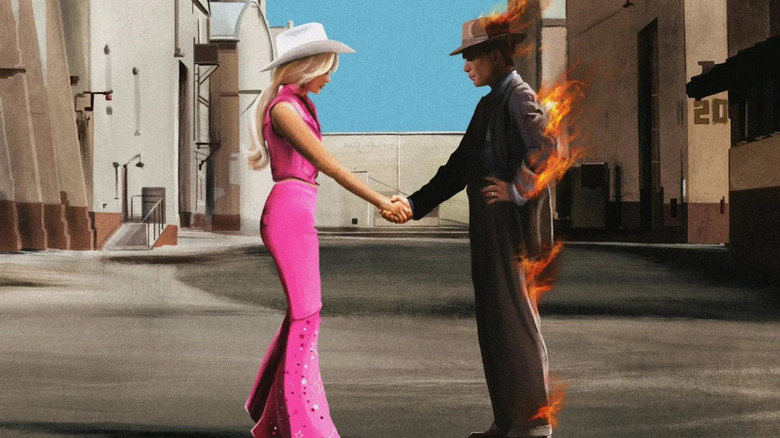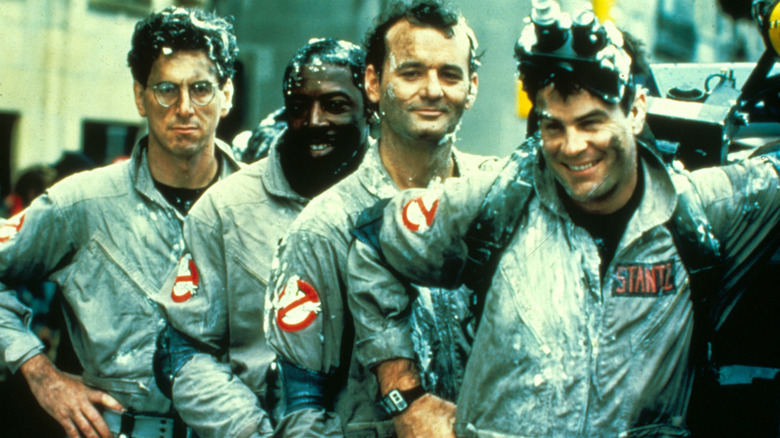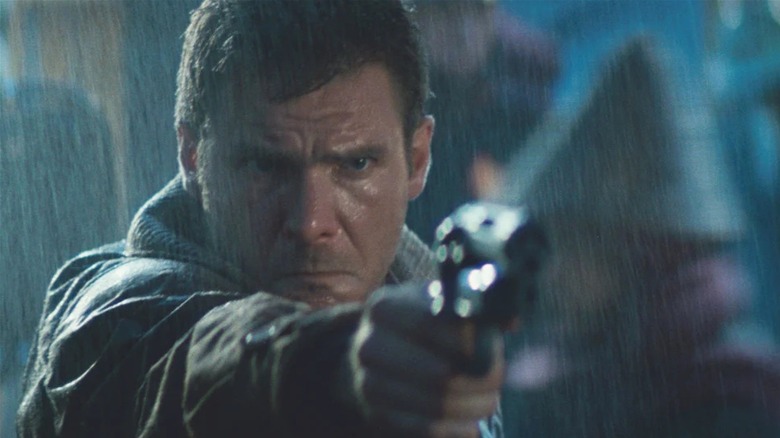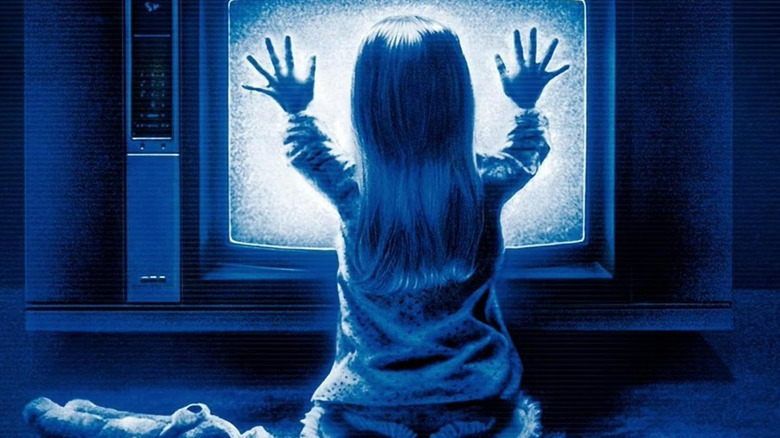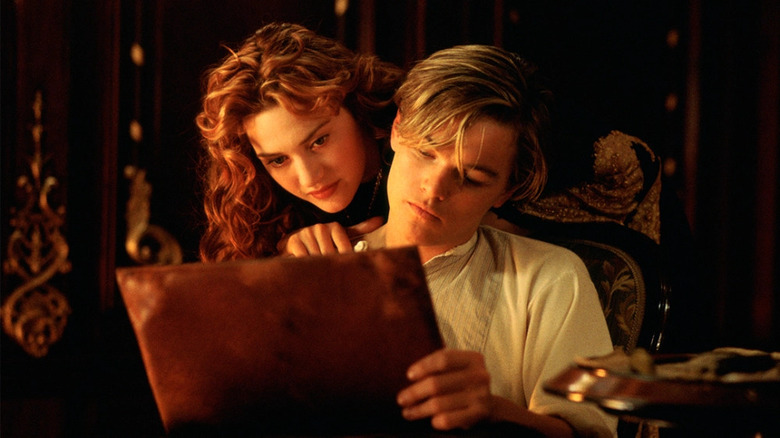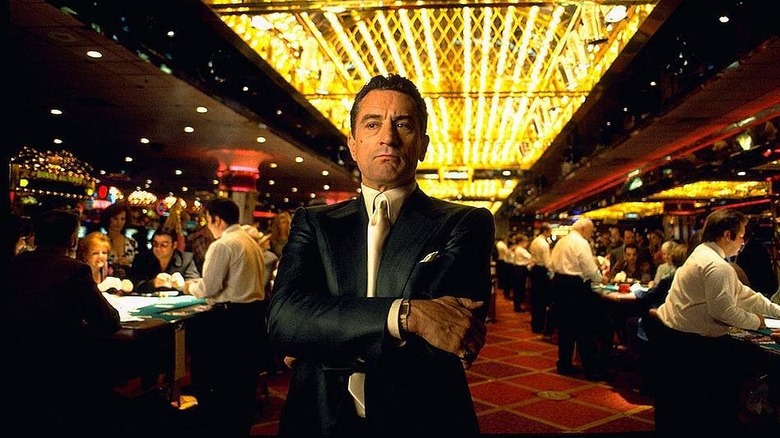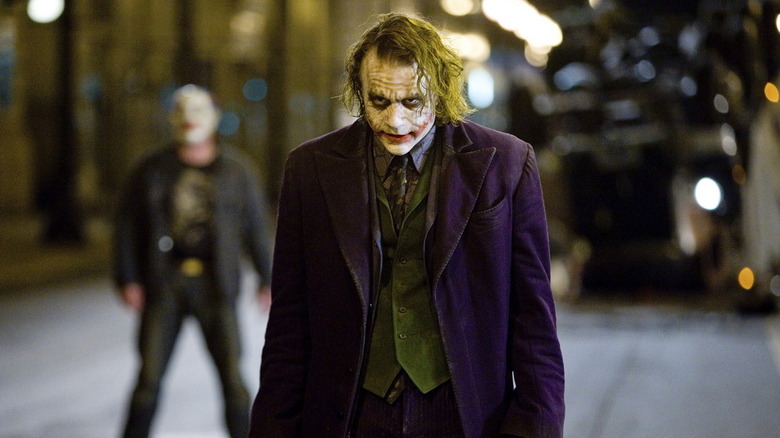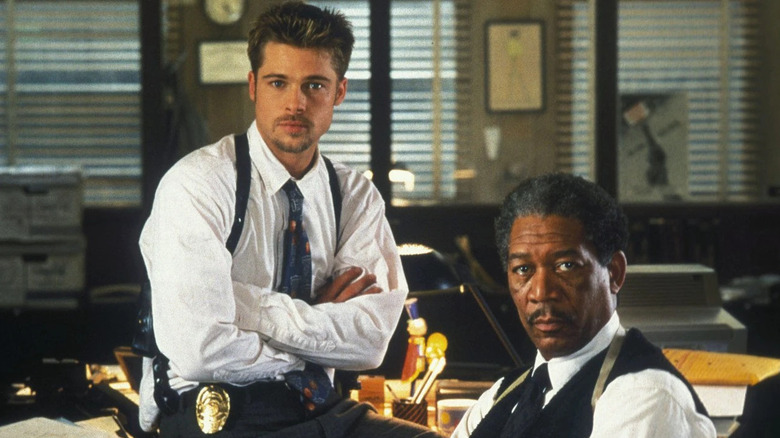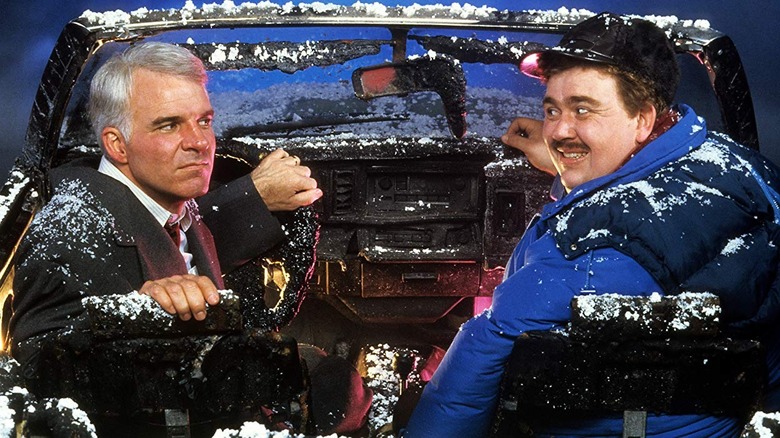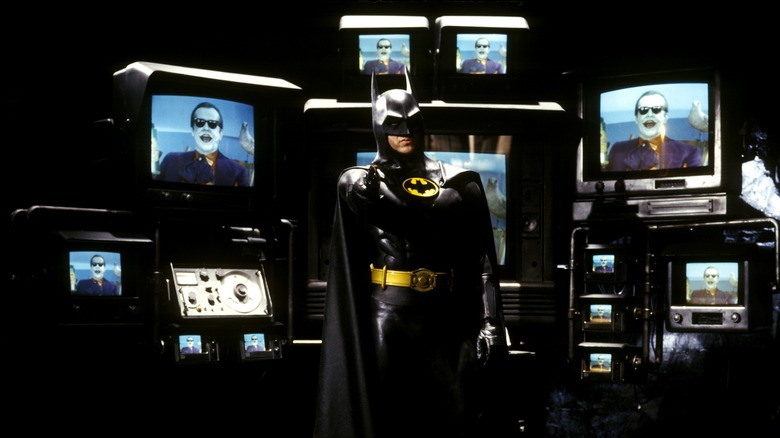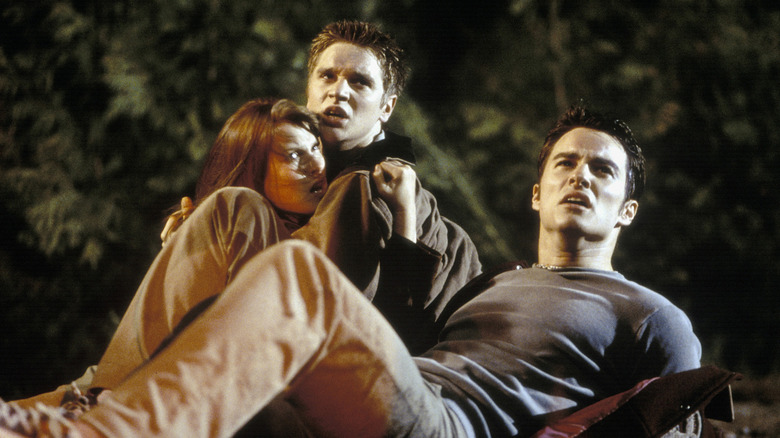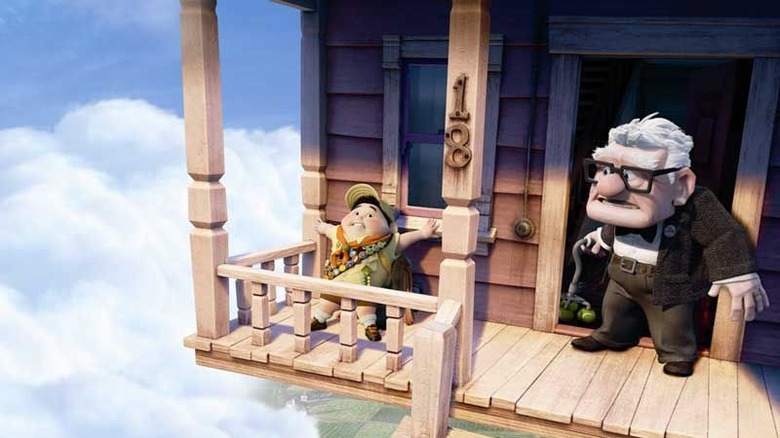Beyond Barbenheimer: 22 Other Iconic Blockbusters That Were Released On The Same Day
The world has caught Barbenheimer fever. Ever since it was revealed last summer that director Greta Gerwig's live-action doll adventure would be released on the same day as Christopher Nolan's brooding biopic of atomic bomb inventor J. Robert Oppenheimer, the internet has been preparing itself for the movie double feature to end all double features. This week, their dual releases resulted in unprecedented box office success for both. "Barbie" is close to half a billion worldwide less than a week into its run, while "Oppenheimer" has blown away all expectations for a talky, R-rated, three-hour biopic, with $200 million in the tank and counting. It's not just a testament to audiences crying out for something new after a mostly disappointing blockbuster summer, but the enduring power of the cinematic double bill.
This isn't the first time movie fans have been faced — or is it blessed — with such an unusual choice when arriving at the box office. See one? See both on the same day? And, if seeing both, in what order? We've taken a look back over the years to pick several iconic movies released on the same day, which would have made for some of the most enjoyable double features of all time.
Ghostbusters/Gremlins (June 8, 1984)
Before something strange arrived in your neighborhood (theater), Columbia Pictures worried they had an all-timer of a flop on their hands with "Ghostbusters," due to a wealth of expensive special effects that made this one of the costliest comedy productions in history at the time. Their fears proved unfounded, as Dan Aykroyd's passion project went on to become one of the year's biggest hits, as well as one of the defining movies of its decade – even though, on its opening weekend, it only managed to narrowly beat a Christmas movie that had been released at the height of summer.
Yes, another spooky comedy arrived in theaters on June 8, as Joe Dante's "Gremlins" started its blockbuster run, terrifying millions of children worldwide, not to mention revealing to them in the process that Santa Claus doesn't exist. The Amblin production caused considerable controversy upon release as one of the first recipients of the PG-13 rating, a then-unthinkable classification for what was marketed as a family-friendly adventure. British censors went even further, handing it a "15" rating, meaning nobody under that age could legally buy a ticket.
Whereas rival studios tend to counterprogram blockbuster releases, this is the rare example of two studios going head-to-head with similar projects; two perfect blends of horror, adventure, and comedy. It's one of the best blockbuster double bills you could ask for.
Blade Runner/The Thing (June 25, 1982)
Released just weeks after Steven Spielberg's "E.T. the Extra-Terestrial" opened to box office success, it's no surprise that two far more pessimistic science fiction films would become colossal failures in its wake. But time has been kind to "Blade Runner" and "The Thing," which were savaged by critics and ignored by audiences upon debut, only for them to evolve into a couple of the most heralded movies of the 80s.
In the case of "Blade Runner," its failure was due to the unsatisfying theatrical cut, with its much-mocked monotonous Harrison Ford voice-over. Years of subsequent director's cuts from Ridley Scott have fixed this issue, and consequently unearthed the tech noir masterpiece hiding in plain sight all along. As for "The Thing," John Carpenter's grim survival horror was roundly panned for its nihilistic nature. Watched now, this is exactly why it packs a punch and stakes a claim as the best of Carpenter's collaborations with star Kurt Russell.
Star Trek II: The Wrath of Khan/Poltergeist (June 4, 1982)
June 1982 truly provided an embarrassment of riches in terms of the major films that arrived in multiplexes. Above everything else, however, it was the summer of Spielberg. A week before "E.T: The Extra-Terrestrial" enchanted audiences, another of his fantastical tales rooted in American suburbia began terrifying them, as director Tobe Hooper's "Poltergeist" became the year's definitive horror sensation. Widely rumored to have been ghost-directed by Spielberg himself, a claim supported and debunked in equal measure over the years, the movie remains crucial to understanding the themes that most intrigue him as a director — in particular, the destruction of a family unit in what seems to be a picture-perfect, all-American suburb. More connects "Poltergeist" and his semi-autobiographical "The Fabelmans" than initially meets the eye, even if a different filmmaker ended up bringing "Poltergeist" to the screen.
"Poltergeist" scared its way into theaters on the same day as "Star Trek II: The Wrath of Khan," with the "Trek" sequel proving to be a high watermark for the franchise on the big screen. For fans of genre cinema, June 1982 rates as a month for the ages. I don't think we've had a run quite like it ever since.
Titanic/ Tomorrow Never Dies (December 19, 1997)
Originally scheduled as a prospective summer blockbuster, an extensive post-production process saw "Titanic" pushed back several times, with executives nervous they had a very expensive bomb on their hands. As we all now know, you should never bet against James Cameron. When his romantic epic finally emerged in time for Christmas, Leonardo DiCaprio and Kate Winslet managed to do the unthinkable and keep James Bond from opening at number one.
Pierce Brosnan's sophomore outing as 007 was the first of several major competitors that couldn't hold a candle to "Titanic" at the box office but was the best complement to it. Cameron's distinct blend of action and melodrama could be lifted directly from the Bond franchise, so of course it would make a perfect pairing with the then-latest outing in the British espionage series. And don't cry for Bond. "Tomorrow Never Dies" raked in $125 million in the U.S. on the way to a worldwide gross of $339.5 million.
Casino/ Toy Story (November 22, 1995)
Pixar was not on anybody's radar back in 1995, meaning that most cinephiles would likely turn their nose up at the thought of watching the studio's debut film, which featured the voices of Tom Hanks and Tim Allen, in tandem with Martin Scorsese's highly anticipated crime epic starring Robert De Niro, Joe Pesci, and Sharon Stone. Looking back at that year's Thanksgiving weekend now, however, reveals a tantalizing double bill of two of Hollywood's most acclaimed films of that year in one place at one time. Could you imagine going from one to the next at the multiplex?
"Casino" may have been one of Scorsese's most hyper-violent efforts by that point, but when watched next to "Toy Story," it does beg the question: are the deformed toys lurking under Sid's bed more terrifying than the sight of Joe Pesci putting someone's head in a vice? I sure know which one has given me more nightmares over the years.
The Dark Knight/ Mamma Mia! (July 18, 2008)
If a Christopher Nolan movie is on the horizon, rival studios will gear up to release what they think is its polar opposite. Before "Barbie" versus "Oppenheimer," we had "Dunkirk" going head-to-head with "Girls Trip" and "Interstellar" duking it out with "Big Hero 6." But the blueprint for Barbenheimer was set in 2008, when audiences were given the choice between a gruesome trip to Gotham City and a whirlwind musical holiday in Greece.
"The Dark Knight" caused considerable controversy upon release for being one of the darkest, most brutal superhero films ever granted a PG-13 rating. It became a juggernaut, but, understandably, audiences might want a lighter alternative after witnessing all the carnage left in the Joker's wake. And what better escapist adventure than "Mamma Mia!"? Initially released to mixed reviews, the ABBA-driven movie defied modest expectations to become the feel-good hit of summer 2008, even as it delivered something even more horrifying than anything in Nolan's Batman sequel: Pierce Brosnan's singing "abilities."
Seven/ Showgirls (September 22, 1995)
This double bill represents a significant turning point for studio filmmaking aimed at adults at the midpoint of the 90s. The erotic-thriller genre, which had been dominant in the preceding years, was already on its way out of popularity when the NC-17-rated "Showgirls" seemed to put the final nail in its coffin upon its much-mocked original release. Thankfully, director Paul Verhoeven's scandalous reimagining of "All About Eve" has been reevaluated as one of the defining cult movies of the 90s, a gloriously OTT exploitation romp that looks camp right in the eye.
Ridiculed for its oversexualized nature — something Verhoeven knowingly pushed to beyond-parody levels — it couldn't be further from the gritty crime drama it was released opposite: David Fincher's "Se7en." The director's gruesome detective movie gave the police procedural genre a shot in the arm and largely explains why the second half of the decade saw multiplexes dominated by all manner of bloody potboilers, many of which cast Morgan Freeman in the hopes of recapturing Fincher's magic. They couldn't get close; nobody has an imagination quite as twisted as his.
Three Men and a Baby/ Planes, Trains and Automobiles (November 27, 1987)
Thanksgiving 1987 gave audiences the choice of two high-concept comedies. Would you opt for Ted Danson, Tom Selleck, and Steve Guttenberg looking after a baby that inexplicably turned up on the doorstep of their bachelor pad, or Steve Martin and John Candy irritating each other in a race-against-time road trip back to their respective Thanksgiving dinners?
The smart option would be to take in both for the ultimate feel-good comedy double bill. I recommend watching "Planes, Trains and Automobiles" second, as it's got the ultimate heartwarming ending. It's still the finest film to bear John Hughes' name as writer-director, and it marked a clear progression for him as a filmmaker, as at this point, he was still deeply entwined with the teen comedy genre. Funnily enough, "Three Men and a Baby" also acted as an attempt at reinvention for its director. Leonard Nimoy enjoyed his greatest box office success to date by shaking off the Spock image and embracing his funny bone behind the camera.
Batman/ Honey, I Shrunk the Kids (June 23rd, 1989)
In recent years, it has become conventional studio wisdom to not release any counter-programming on the same weekend as a gigantic superhero tentpole; it'll swallow up all the screens, not to mention the profits, and your film will be relegated to tiny auditoriums as a result. Tim Burton's "Batman" may have been the most anticipated film in history when it arrived in theaters in Summer 1989, but it debuted at a time when this alone wasn't enough to dissuade Disney from putting up some competition against it.
Burton's "Batman" set the ball rolling for grittier screen interpretations of Bruce Wayne than the campy Adam West adventures audiences were accustomed to, with Gotham transformed into a German Expressionist nightmare complete with endless villains as threatening as they were theatrical. It's probably no surprise that some parents may have opted to take their children to a different film altogether, with the family comedy "Honey, I Shrunk the Kids" perfectly fitting the bill. Despite opening next to a Bat-shaped behemoth, it ended up as one of the year's highest-grossing films.
Erin Brockovich/ Final Destination (March 17, 2000)
Consider this a perfect high art/low art double bill. You've got a future Best Picture nominee (and Best Actress winner, for a never-better Julia Roberts) battling it out against a trashy, high-concept teen horror flick. "Final Destination" ultimately satisfies in its own right -– even if it, in this writer's opinion, didn't fully live up to its potential the way several of its even more bonkers sequels did.
Director Steven Soderbergh's legal biopic was one of the first true crowd-pleasers of the new millennium, as well as one of the first signs of his career-long swerves between populist studio fare and experimental indies he'd shoot on the cheap with whatever equipment he'd have on hand. It makes for a far better companion piece to "Final Destination" than you'd expect too. Ultimately, these are both about characters struggling to warn others about something that'll have grave, life-threatening consequences for them, and fighting a hard battle to get themselves heard.
Drag Me to Hell/ Up (May 29, 2009)
By the time "Up" came around, the world considered Pixar a cinematic institution. And they reached new critical heights with this movie, which world premiered as the kickoff movie at that year's Cannes Film Festival and went on to become Pixar's first Best Picture nominee. Also by this point, it was well established that Pixar movies tended to transform audiences into emotional wrecks, although "Up" set new records in that regard, reducing viewers into floods of tears by the 15-minute mark, as the opening montage hit its climax.
It was the first Pixar movie that played on the emotions of parents rather than the child target audience, and as a result, any adult viewer probably needed a lot more than the comic adventure that followed that opening to get their spirits back to normal. Step forward Sam Raimi's joyously deranged "Drag Me to Hell," his much-anticipated return to horror following the "Spider-Man" trilogy, which delivered belly laughs, jump scares, and audible groans of disgust at its sheer and plentiful grossness.
Many view Raimi's movie as the most nihilistic in his back catalog, especially regarding the eventual fate of its protagonist. But as a pure shot of horror-comedy brilliance, it's hard to fault. If "Up" leaves you emotionally drained, watching this directly afterward will energize you anew.
